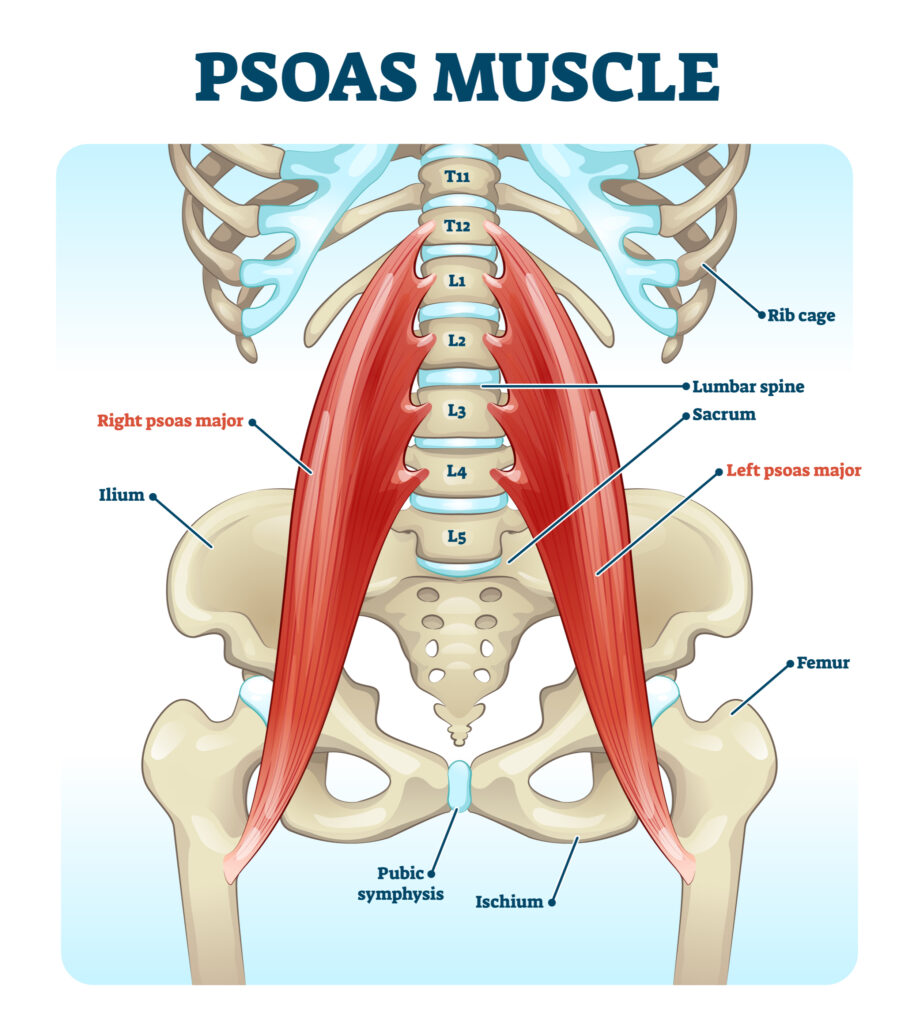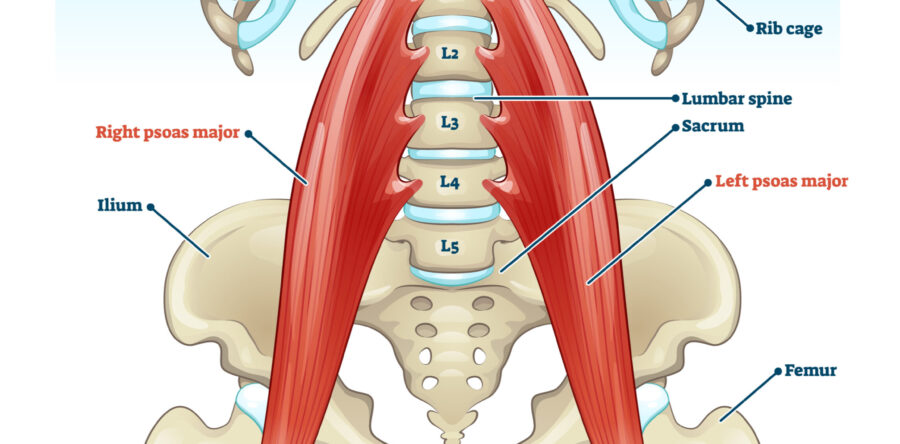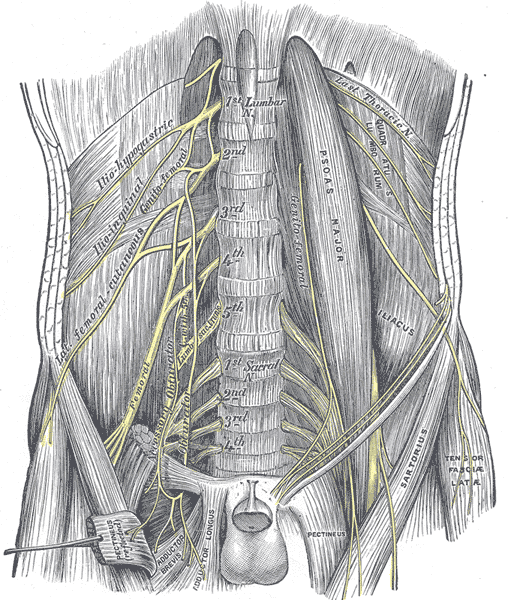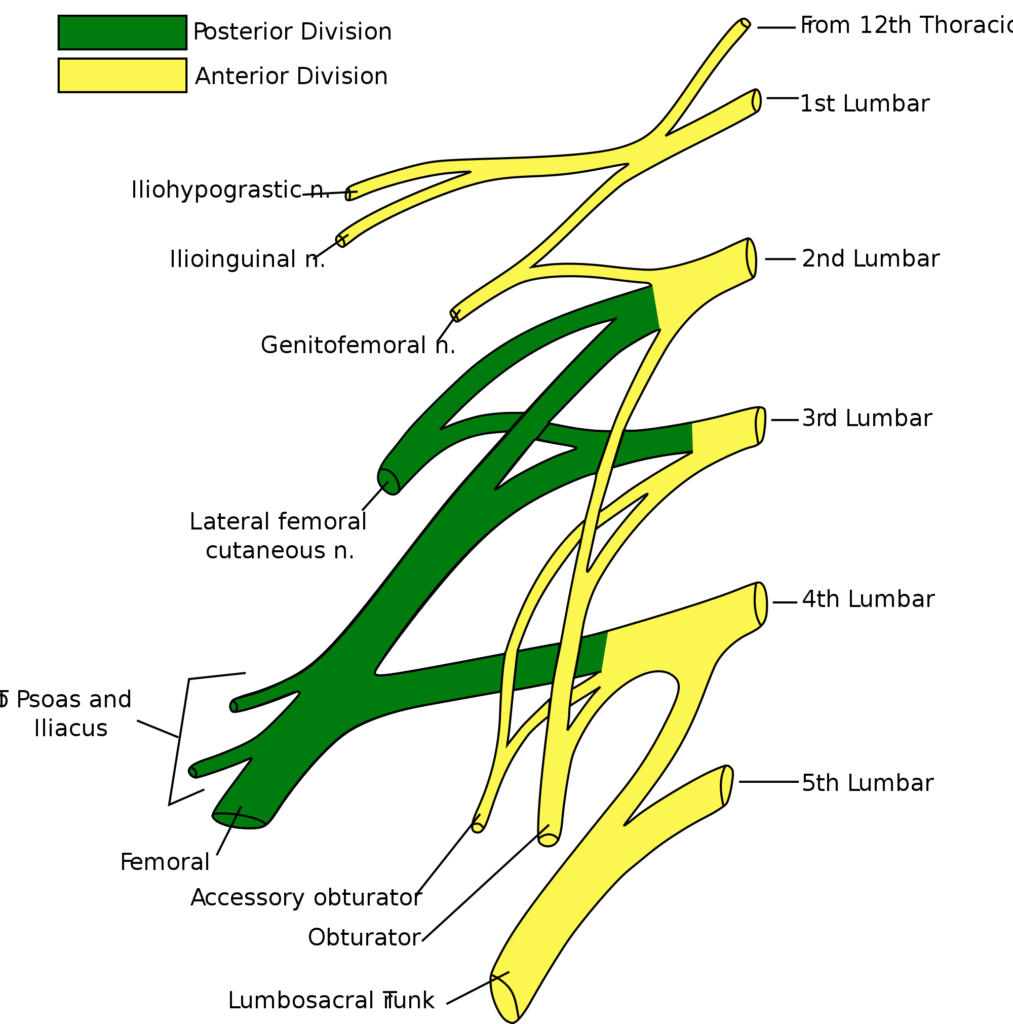Understanding The Psoas: Muscle of the Soul
The Psoas, is one of my most favorite muscles! As a Manual Physical Therapist specializing in both Pelvic Floor Dysfunction and Chronic Pain, treatment including the psoas is almost always a part of my treatment plan. I am amazed and humbled by its broad reaching clinical presentation which often goes overlooked. Psoas dysfunction can contribute to many physical conditions including pelvic floor dysfunction, low back pain, groin pain, pelvic unleveling, sacroiliac joint pain, leg-length discrepancy, functional scoliosis, hip pain, hip snapping, knee pain, dysmenorrhea, dyspareunia, bladder and bowel conditions and constipation to name a few. Decreased energy or feelings of well-being can also be attributed to psoas dysfunction given its relationship between the psoas and diaphragm, psoas and sympathetic trunk and psoas and nearby organs. The psoas affects the body, mind and spirit and is perfectly referenced as the "Muscle of the Soul!"
Muscle of the Soul is a term given to the psoas major muscles in the teachings of the Universal Healing Tao System. It indicates how vital the psoas is to our skeletal structure, organs and general energy state according to Mantak Chia in his book, Energy Balance Through the Tao.
Understanding the Psoas
...its origin, insertion and nearby neuromuscular and organ systems can explain how the psoas’s role can expand to effect many more systems when it becomes dysfunctional. Below I will discuss these specific components in regards to the psoas:
- Musculoskeletal
- Fasica
- Myofascial Trigger Points
- Diaphragm and Pelvic Floor Fascial Connections
- Nervous System
- Neuromuscular
- Sympathetic Fight or Flight
- Emotional and Energy Balance
- Energy Balance through the Tao
- Organ Connection
- Treat the Body as a Whole
As a holistic practitioner working with complex chronic conditions, I respect and understand that everything affects everything; I listen very carefully to my patient's story, they will lead the way; this is utmost to helping and healing...my journey with them has driven me to gain more tools in order to help...finding the perfect recipe their body needs!
Musculoskeletal
 Function
Function
The Psoas is a very important muscle for many reasons. Most people are aware of its action, as part of the iliopsoas muscle, to flex the hip; curling up into a ball or helping us to stand erect, walk and spring into action. With unilateral contraction of the psoas, it contributes to side bending the lumbar spine and bilateral contraction helps to raise the trunk from supine.
Attachments
The Psoas Muscle originates from T12 to L5 (transverse processes of L1-5, bodies of T12-L5 and intervertebral discs below bodies of T12-L4) and inserts at the lesser trochanter of the femur.
Clinical Significance
Look at the above picture...Just by understanding its attachments to the lumbar spine one can see how a tight and in spasm psoas can pull, compress and cause traction, creating back pain.
Posture
Our skeletal system can be divided into two regions, the axial (skull, spine, ribs and sternum) and appendicular skeleton (girdle and limbs). The psoas joins these two major regions together, the central spine to the legs. It also connects the upper to lower body through the fascial connections with the diaphragm and the back (spine) to the front (attachments on the femur).
Clinical Significance
A psoas muscle that is tight or in spasm, unilaterally or bilaterally, can cause significant changes in posture that can cause pain anywhere in the upper or lower body. Postural misalignment examples can include pelvic tilting, pelvic rotation, increased lumbar lordosis and externally rotated legs and feet. Again think of its muscle attachments; if the psoas is tight and shortens it can pull the posture out of alignment.
"The appearance of a protruding belly can visually indicate a hypertonic psoas, which pulls the spine forward while pushing the abdominal contents outward." www.everipedia.com-Psoas major muscle
Myofascial
Myofascia or Fascia is strong sheet of connective tissue that attach, enclose and separate muscles and organs. Myofascial trigger points are painful points or nodules in the fascia or surrounding muscle. Trigger points as coined by Dr. Janet Travell can refer pain to a typical distribution pattern of the specific muscle. In her book, Myofascial Pain and Dysfunction: The Trigger Point Manual, she refers to the iliopsoas muscle (iliacus and psoas) as the hidden prankster. You can see why below...check out triggerpoint.net primary symptoms and referred pain pattern of the iliopsoas. As with any condition, it is important to be evaluated by a medical doctor for differential diagnosis and diagnostic testing to rule out actual medical conditions that may require medical attention.
Primary Symptoms
Source: www.triggerpoints.net/muscle/iliopsoas
Diaphragm and Pelvic Floor Facial Connections
"The fascial relations of the psoas major to the surrounding tissues warrant special attention as these links influence the biomechanics of these interlaced structures. The medial arcuate ligament is a continuation of the superior psoas fascia that continues superiorly to the diaphragm. The right and left crus constitute the spinal attachment of the diaphragm. They attach to the anterolateral component of the upper three lumbar vertebral bodies. The crus and their fascia overlap the psoas major and appear to be continuous with this muscle until they come more anterior and blend with the anterior longitudinal ligament.8 As the psoas descends, its inferomedial fascia becomes thick at its inferior portion and is continuous with the pelvic floor fascia.9 This forms a link with the conjoint tendon, transverse abdominus, and the internal oblique.10 As the psoas major courses over the pelvic brim, the fascia of the posterior fascicles attach firmly to the pelvic brim." Sajko, et al: Psoas Major: a case report and review of its anatomy, biomechanics, and clinical implications; J Can Chiropr Assoc. 2009 Dec; 53(4): 311–318.
Clinical Significance
Understanding the fascial connections of the psoas will reveal the overreaching effect it can have in dysfunction. This may not always be the case, but can you see how psoas muscle dysfunction could potentially cause restriction of the diaphragm and or pelvic floor and conversely, pelvic floor dysfunction and or diaphragm restriction cause dysfunction of the psoas...
Neuromuscular System
The lumbar plexus lies underneath the psoas major muscle. Look at the picture below; on one side the psoas muscle is reflected and you can see the lumbar plexus. The lumbar plexus is made up of a bunch of nerves including Iliohypogastric, Ilioinguinal, Genitofemoral, lateral Femoral Cutaneous, Obturator and Femoral.
Clinical Significance
The Lumbar Plexus is made up of several motor and sensory nerves; any of which can be affected by a dysfunctional psoas. Example: "A hypertonic and inflamed psoas can lead to irritation and entrapment of the iliolinguinal and the iliohypogastric nerves, resulting in a sensation of heat or water running down the front of the thigh". www.everipedia.com-Psoas major muscle
Sympathetic Nervous System: Fight or Flight
Our autonomic nervous system controls the functions of our body not under our conscious control such as breathing, heart rate, digestion and respiratory rate. The sympathetic nervous system and parasympathetic are the two main divisions of the autonomic nervous system. The sympathetic nervous system is responsible primarily to stimulate the body for fight or flight while parasympathetic for calming.
Note that the sympathetic nervous system (see sympathicus diagram below) originates in the spinal cord and extends as the sympathetic chain along either side of the spinal column from the thoracic to the lumbar vertebra. As discussed, the diaphragm and psoas connect in the region of the thoracic spine and psoas respectively from T12 to L5, again where a large part of the sympathetic system resides.
Emotional and Energy Balance
Clinical Significance
Well, what does this all mean? Is it possible that a hypertonic psoas and significant diaphragm restriction, based on their proximity and fascial connections, can have an affect on the sympathetic nervous system... revving up the flight or flight response, like having the the gas petal stuck in a down position? And how would this present clinically in terms of energy or emotional state? So for the psoas muscle that curls us into a ball for protection or helps us to spring into action for flight....is there a connection...
Many many years ago I was blessed to come across this book, The Psoas Book, By Liz Koch. It has provided me with a profound way of thinking when evaluating patients and a deep understanding of how everything effects everything...and even more so when I began to see the psoas connection in treating pelvic floor dysfunction and chronic pelvic pain back in 2001. Thank you Liz Koch for your tremendous research and dedicated work in this area. Below is an excerpt from The Whole Woman Village Post, Psoas, Instinctive Responses & The Healthy Pelvis, by Liz Koch -
"Although the psoas has been thought to serve the spine as a guide wire creating stabilization, its main job is to message subtle changes in weight, location, and safety. The psoas bridges the belly enteric brain, central, and autonomic nervous systems. The large nerve ganglion located within the belly core going to the digestive and reproductive organs passes over, embeds into, and through the psoas. Serving as messenger of the core our psoas translates and transmits all expressions of safety, harmony, and integrity; signaling whether or not we are centered and congruent or encumbered and vulnerable." She further states in her book, "Because the psoas is so intimately involved in such basic physical and emotional reactions, a chronically tightened psoas continually signals your body that you’re in danger, eventually exhausting the adrenal glands and depleting the immune system,”
Energy Balance through the Tao
In Energy Balance through the Tao, Mantak Chia discusses how vitality and health begin at the the body's center known as the tan tien. The tan tien is located in the pelvis (pelvic bowl) and movement according to the Tao should begin there. He goes on to discuss that the psoas being a major mover of the body's center, that when dysfunctional, can cause a depletion of energy as movement from the center or tan tien would be difficult.
Organ Connection
Mantak Chia also discusses the psoas's relationship to support and hold the organs in the tan tien and its special relationship with the kidneys (positioned on the psoas). He states, what effects the psoas can effect the kidneys and vice versa. According to Chinese medicine, the kidneys are affected by cold and fear and therefore those same emotions can affect the psoas. In addition, Mantak Chia explains the relationship between the heart and kidneys and psoas and diaphram; when these are balanced the psoas will release. The psoas and its significance in the body's center or tan tien and major role on body structure, balance, emotions and energy, has rightfully been given the name, "Muscle of the Soul."
Treat the Body as a Whole
I am so passionate about the psoas because it truly plays a significant role in helping my patients get well including those with pelvic floor dysfunction, bowel and bladder issues, digestive issues, chronic pain, chronic fatigue, chronic pelvic pain, back pain and other nagging pains during sports. Specific Manual Physical Therapy treatment and exercises will vary as with any condition; Reiki is helpful to support the body’s natural ability to restore balance and Ki energy flow. Treating the body as a whole is key. I hope that this article will provide an understanding that pain or disharmony in the body can be a hidden prankster. But the body is magnificent and has the ability to heal. Listen to your body, trust in your body, support yourself with good practitioners; Physical Therapy, Craniosacral Therapy, Reiki, Health Coaching- Whole Food Nutrition, Acupuncture, Chiropractic, Mental Health Therapy and Primary Care or Specialist and be good to yourself; breathe, relax, meditate and be in nature. Uncover what is driving the holding pattern to unlock recovery...is it your emotions, is it a physical body imbalance or is it depleted life force energy in your organs or meridians; treat the body as a whole. Under the advice of your doctor or physical therapist, consider exercising for the whole body, exercises which cultivate internal life force energy (chi, ki, prana) as well as physical health: physical therapy exercises, stretching, yoga, qigong or tai chi. Find balance in your center, Muscle of the Soul!
Best of Health,
Sandra
Resources and Links
Energy Balance Through the Tao by Mantak Chia
https://www.everipedia.com/Psoas_major_muscle/
https://www.everipedia.com/Iliopsoas/
https://en.wikipedia.org/wiki/Fascia
Myofascial Pain and Dysfunction: The Trigger Point Manual by Janet Travell
www.triggerpoints.net/muscle/iliopsoas
https://en.wikipedia.org/wiki/Myofascial_trigger_point
https://en.wikipedia.org/wiki/Lumbar_plexus
https://en.wikipedia.org/wiki/Autonomic_nervous_system
https://en.wikipedia.org/wiki/Sympathetic_nervous_system
https://commons.wikimedia.org/wiki/File:Gray391.png
https://commons.wikimedia.org/wiki/File:Lumbar_plexus.svg
http://Henry Vandyke Carter, Public domain, via Wikimedia Commons
https://commons.wikimedia.org/wiki/File:The_Autonomic_Nervous_System.jpg
DISCLAIMER: The content on the blog for Evoke Physical Therapy and Wellness Center, LLC is for educational and informational purposes only, and is not intended as medical advice. The information contained on this blog should not be used to diagnose, treat or prevent any disease or health illness. Any reliance you place on such information is therefore strictly at your own risk. Please consult with your physician or other qualified health care professional before acting on any information presented here.
Read more




